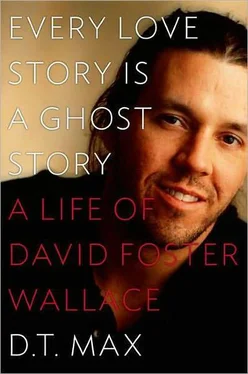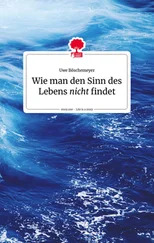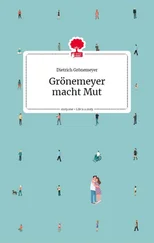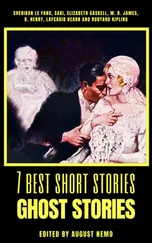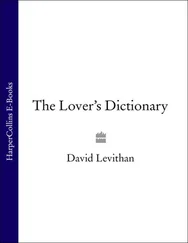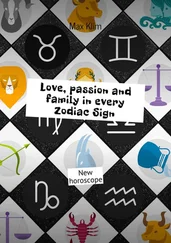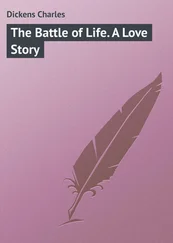Wallace drove east to Saratoga Springs in July 1987. In Urbana, before leaving, he had spent his evenings relaxing with pot and bourbon and videos. Amy was also there. “God I feel lucky to have a sister who’s also a prized friend,” he wrote JT. But he’d also pushed forward quietly with his new story. One day Amy came downstairs to find her brother in the kitchen frying a rose in a pan and he said it was for something he was working on. At Yaddo he was taken, as so many writers had been before him, with the gothic main hall in the mansion, the smaller houses on the four hundred acres of grounds, the grand expanse devoted to literature and art. Roughly a dozen writers were in residence, alongside composers and other artists. Wallace felt proud to be among them. This was creative life as he had never experienced it, and, ever competitive, it excited him to be among the best.
Wallace had brought along his story-in-progress to work on. He quickly took it up again. The story takes as its point of departure John Barth’s long story “Lost in the Funhouse,” a touchstone of postmodern fiction written in 1967 that Wallace had long loved. “Funhouse” tells the story of two brothers, Ambrose and Peter, whose parents drive them to an amusement park in Ocean City, Maryland, on a summer weekend during World War II. The two boys are competing for the attention of a young family friend, Magda, who has also come along — and at story’s end we find Ambrose, the younger of the two, lost in the amusement park funhouse, literally and metaphorically left behind by Peter and the girl.
This is all conventional enough storytelling. As Wallace would promise in “Westward” of a similar plot in his own story: each character will experience “numerous insights, revelations and epiphanies; and will, ultimately, at the end of the time confront his future.” But within his conventional matrix, Barth consistently breaks through the narrative wall to remind the reader what he or she is experiencing as real is an artifact, words on paper. So the narrator keeps track of how long it takes his characters to get to the amusement park. He can be didactic, noting after a string of deftly turned images their function in fiction: “It is…important to ‘keep the senses operating’; when a detail from one of the five senses, say visual, is ‘crossed’ with a detail from another, say auditory, the reader’s imagination is oriented to the scene, perhaps unconsciously.” And when the three teenagers are horsing around a pool, he interrupts to note, “The diving would make a suitable literary symbol.” He interferes with the seductions of fiction by unmasking them.
It is easy to see why this sort of performance had for so long resonated with Wallace. Metafiction was the sort of technique that had first formed the bridge for him from philosophy to fiction when he was at Amherst. It contained that second level of meaning that made Wallace confident that what he was reading was intellectually richer than just entertainment (“meatfiction,” the narrator of his new story calls it), and it was clever and sardonic, just as Wallace was. Indeed, Barth had been one of the original stars in Wallace’s firmament, along with Barthelme. And in “Lost in the Funhouse,” he shows himself to be just the sort of fiction teacher Arizona lacked — Wallace’s own story featuring diving, “Forever Overhead,” had won great praise in Tucson, even as he saw how thin it was. Barth, then, was the teacher Wallace deserved, “Lost in the Funhouse” the wise, self-aware text his own teachers could never produce to help him on his own way.
And that had been Wallace’s whole response for a time. But as he finished his work at Arizona, he also had come to feel that there was something irritating about “Lost in the Funhouse,” condescending, and, if you were a recursive cast of mind, false about the way Barth kept breaking into the narrative to show readers falsity. Didn’t such an intrusion, in the end, just create more of a performance? Wasn’t it seduction pretending to be renunciation? How in the end did Barth really propose to challenge or reward the reader? Preparing to rebut Barth in his own story, Wallace scribbled notes in the margins of his paperback of the Lost in the Funhouse story collection, contesting sentences and penning criticisms like “Talmudic — obsessed w/its own interpretation” alongside Barth’s words. It was clear that metafiction no longer satisifed Wallace as it once had. But just after his last semester at Arizona, when he probably began his new story, he himself likely couldn’t tell whether he was writing an homage, a parody, a eulogy, or an act of patricide. The desire to get out what he had to say was made more intense by his sense that his old life was ending: this was the time for last things, for summings up, for boiling the whole of the fictive act, at least as practiced in MFA programs, down to, as he would later tell an interviewer, “this tiny, infinitely dense thing.” To strike down metafiction was also to show what was next, to point the way forward; it was also, in a way, a promise to go beyond what Wallace had been able to achieve in the stories he’d written at Arizona in their farrago of postmodern styles. As the poem by Bishop Berkeley from which the novella title derives concludes:
Westward the course of empire takes its way;
The first four Acts already past,
A fifth shall close the Drama with the day;
Time’s noblest offspring is the last. 1
Like “Funhouse,” “Westward the Course of Empire Takes Its Way” is the story of a group of young people on a car trip. But instead of Barth’s ordinary American teenagers, Wallace gives us MFA students. And rather than go to a beach, they are on a more typically postmodern errand. They are on the way to the town of Collision, Illinois, for a reunion of the forty-four thousand “former actors, actresses, puppeteers, unemployed clowns” who have ever taken part in a McDonald’s commercial. At the same time there will be a ribbon-cutting for a “flagship discotheque” of a new company, whose goal is to “build a Funhouse in every major market.” Running this effort to add “a whole new dimension in alone fun” are two people: Leo Burnett, the advertising guru, and none other than John Barth, the metafictionist called her Professor Ambrose (for legal reasons Burnett’s name is changed to J.D. Steelritter in the published version of the book). Wallace’s suggestion is clear: advertising and metafiction share the same goal, to lull by pleasing, to fatten without nourishing. A third intoxicant is present in the story as well: a marijuana-like product derived from frying roses, which Steelritter has discovered and expects to serve the actors who participate in his great final commercial to some unspecified apocalyptic end. 2
This two-sided slash at advertising and metafiction was where Wallace’s story began, but as he worked on it, it kept outgrowing its original shape, lengthening, if not deepening. 3Most notably, it came to annex the tempestous story of Wallace and Walden. Wallace felt their relationship was ending and their connection needed telling before, like his life in Arizona, it was gone forever. Wallace himself appears, altered, in two places in “Westward”: he bears a resemblance to one of the students in the car, Mark Nechtr, a competitive archer, fried rose addict, and MFA student at Ambrose’s East Chesapeake Tradeschool (note the initials), “a boy hotly cocky enough to think he might someday inherit Ambrose’s bald crown and ballpoint scepter, to wish to try and sing to the next generation of the very same sad kids.” For Nechtr, as for Wallace, metafiction is an addiction, exerting “a kind of gravitylike force” on him at the same time as he tries to fight its malign influence, “feel[ing] about Allusion the way Ambrose seems to feel about Illusion.” Nechtr is also Wallace’s inverse — full of promise but too blocked to write a word. At Nechtr’s side is Drew-Lynn Eberhardt, another student in the program. D.L. is at once alluring and off-putting. She has some of Walden’s affect, “reads painted Elkesaite cards, knows her own rising sign, and consults media.” She is also working on a long poem consisting only of punctuation. The couple are married but in a sexless relationship, D.L. pretending — or perhaps believing herself to be — pregnant.
Читать дальше
